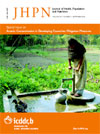
|
The Journal of Health, Population and Nutrition
icddr,b
ISSN: 1606-0997
EISSN: 1606-0997
Vol. 31, No. s2, 2013, pp. 106-128
|
 Bioline Code: hn13081
Bioline Code: hn13081
Full paper language: English
Document type: Editorial
Document available free of charge
|
|
|
The Journal of Health, Population and Nutrition, Vol. 31, No. s2, 2013, pp. 106-128
| en |
A Taxonomy and Results from a Comprehensive Review of 28 Maternal Health Voucher Programmes
Bellows, Ben W.; Conlon, Claudia M.; Higgs, Elizabeth S.; Townsend, John W.; Nahed, Matta G.; Cavanaugh, Karen; Grainger, Corinne G.; Okal, Jerry & Gorter, Anna C.
Abstract
It is increasingly clear that Millennium Development Goal 4 and 5 will not be achieved in many low- and
middle-income countries with the weakest gains among the poor. Recognizing that there are large inequalities
in reproductive health outcomes, the post-2015 agenda on universal health coverage will likely generate
strategies that target resources where maternal and newborn deaths are the highest. In 2012, the United
States Agency for International Development convened an Evidence Summit to review the knowledge and
gaps on the utilization of financial incentives to enhance the quality and uptake of maternal healthcare.
The goal was to provide donors and governments of the low- and middle-income countries with evidenceinformed
recommendations on practice, policy, and strategies regarding the use of financial incentives,
including vouchers, to enhance the demand and supply of maternal health services. The findings in this
paper are intended to guide governments interested in maternal health voucher programmes with recommendations
for sustainable implementation and impact. The Evidence Summit undertook a systematic
review of five financing strategies. This paper presents the methods and findings for vouchers, building on
a taxonomy to catalogue knowledge about voucher programme design and functionality. More than 120
characteristics under five major categories were identified: programme principles (objectives and financing);
governance and management; benefits package and beneficiary targeting; providers (contracting and service
pricing); and implementation arrangements (marketing, claims processing, and monitoring and evaluation).
Among the 28 identified maternal health voucher programmes, common characteristics included:
a stated objective to increase the use of services among the means-tested poor; contracted-out programme
management; contracting either exclusively private facilities or a mix of public and private providers; prioritizing
community-based distribution of vouchers; and tracking individual claims for performance purposes.
Maternal voucher programmes differed on whether contracted providers were given training on clinical or
administrative issues; whether some form of service verification was undertaken at facility or communitylevel;
and the relative size of programme management costs in the overall programme budget. Evidence
suggests voucher programmes can serve populations with national-level impact. Reaching scale depends
on whether the voucher programme can: (i) keep management costs low, (ii) induce a large demand-side
response among the bottom two quintiles, and (iii) achieve a quality of care that translates a greater number
of facility-based deliveries into a reduction in maternal morbidity and mortality.
Keywords
Demand-side financing; Maternal healthcare; Results-based financing; Vouchers
|
| |
© The Journal of Health, Population and Nutrition
Alternative site location: http://www.jhpn.net
|
|
